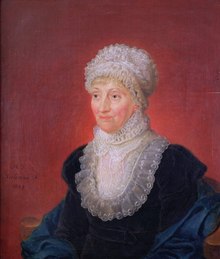List of 999 women on the Heritage Floor / Caroline Herschel
This list describes the place setting for Caroline Herschel on the table of Judy Chicago's art installation The Dinner Party . It is part of the list of 999 women on the Heritage Floor who are assigned to the respective place settings on the table. The names of the 999 women are on the tiles of the Heritage Floor, which is arranged below the table and belongs to the art installation.
description
The installation consists of a three-sided table, each with 13 historical or mythological personalities, thus a total of 39 people, from prehistory to the women's rights movement . These people were assigned a place setting at the table, consisting of an individually designed table runner, an individually designed plate, a goblet, knife, fork, spoon and serviette. The first page of the table is devoted to prehistory up to the Roman Empire , the second to Christianization up to the Reformation and the third from the American Revolution to the women's movement. Each place setting on the table is assigned additional personalities who have received an entry on the tiles of the Heritage Floor, which occupies the space under the table and the center of the space between the sides of the table. This list includes the personalities assigned to Caroline Herschel's place setting. Your seat is on the third side of the table.
Hints
In addition to the names as they are used in German transcription or in scientific usage, the list shows the spelling chosen by Judy Chicago on the tiles.
The information on women who do not yet have an article in the German-language Wikipedia is referenced by the individual references listed under comments . If individual information in the table is not referenced via the main article, additional individual references are given at the relevant point. If there are any discrepancies between the information provided in Wikipedia articles and the descriptions of the work of art on the Brooklyn Museum website , this will also be indicated under Comments.
Place setting for Caroline Herschel
Caroline Herschel was born on March 16, 1750 in Hanover . In addition to a sister who died as a toddler, she grew up with four brothers. Her father was a military musician and at the same time interested in philosophy and astronomy. He passed this interest on to his children, including his daughter, and two of their brothers also became musicians and astronomers. Together with her brothers, Herschel was able to attend the garrison school and learn to read and write, which was not a matter of course for a middle-class girl. Contrary to the wishes of her mother, who wanted her to train as a seamstress, she followed her father's advice and trained as a concert singer.
At the age of 22 she followed her brother Friedrich Wilhelm Herschel to England, who was employed as organist and concert director in Bath , in order to run his household there. At the same time, her brother helped her to escape the confines of her parents' home, to develop herself musically, and she was able to perform as a soloist in concerts. In addition to her appearances, Caroline Herschel devoted herself to astronomy. She helped make mirror telescopes . Your part was the job of polishing and grinding the mirrors. In addition, she dealt with astronomical theory.
After her brother discovered the planet Uranus in a sky survey in 1781 , King George III offered him a a job as an astronomer in the town of Slough , which he accepted. Caroline was also offered a job as her brother's assistant. She had to decide whether to accept it or to continue her successful career as a singer. She decided to follow her brother, whom she greatly admired, and accepted the job. She began to systematically explore the starry sky, looking for comets. She discovered astronomical nebulae and eight comets and created an index to John Flamsteed's observations, along with a catalog of 561 stars that were missing from his British Catalog and a list of errors in this publication.
Together with her brother she worked, noted the positions of the stars that he called out to her, evaluated the records, wrote treatises for the Philosophical Transactions , discovered other nebulae and calculated hundreds. Her work has been recognized by the most important mathematicians and astronomers, including Carl Friedrich Gauß and Johann Franz Encke . After the death of her brother she returned to her hometown Hanover. In Hanover she continued to work as an astronomer and arranged the material of her brother, which her nephew John Herschel used as the basis for his work.
She has received numerous awards. She received the gold medal of the Royal Astronomical Society in 1828 and was made an honorary member of the Royal Astronomical Society in 1835. She was made a member of the Royal Irish Academy of Sciences in Dublin in 1838. She was 88 years old at the time. On behalf of the King of Prussia , she received the gold medal of the Prussian Academy of Sciences in 1846 . The Crown Prince couple received her when she was 97 years old, they talked lively for a few hours and Caroline sang them a song that her brother had composed. She died on January 9, 1848 and was buried in Hanover.
Your place setting at the dinner table is designed as a reference to astronomy. Your plate is designed centrally by one eye. It is intended to recall Herschel's observations of the sky through her telescope in order to discover further components of the universe. From the eye in the center of the plate, four rays run in the four cardinal directions to the edge of the plate. The table runner is designed with numerous astronomical symbols. The background colors are deep blue and deep black, with clouds, stars and comets embroidered on them. In the center there is a brightly shining sun on which the plate is placed. Astronomical notations and references to the trajectories of comets are embroidered on the back of the runner. Her name is embroidered in gold on the front; The initial letter "C" is decorated by a telescope that her brother gave her and with which Caroline Herschel started her career.
| Surname | Spelling on the tile | Date of birth | cultural spatial assignment | Remarks | image |
|---|---|---|---|---|---|
| Angélique du Coudray | Angélique de Coudray | around 1712 | Kingdom of France | Court midwife of Louis XV. of France , who trained around 4,000 poor French women to be midwives. Invented the first life-size doll for practicing childbirth. |
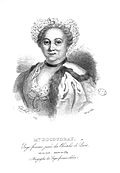
|
| Anna Morandi Manzolini | Anna Manzolini | 1714 | Bologna | As an honorary professor, she taught anatomy at the University of Bologna and is known for her anatomically precise wax replicas of human organs and body parts. |
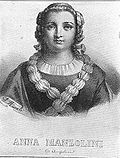
|
| Anne Halkett | Anne Halkett | 1623 | England | Writer best known for her autobiography and religious writings. |
|
| Annie Jump Cannon | Annie Jump Cannon | 1863 | United States | Astronomer , became known for the motto Oh, Be A Fine Girl - Kiss Me! which generations of astronomers taught the order of the spectral classes . In 1929, the National League of Women voters listed her as one of the twelve greatest American women alive. |
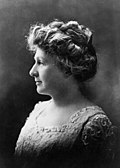
|
| Catharina Schrader | Mrs. Cramer | 1656 | Netherlands | Midwife known for her extensive record of births in the early modern period. |
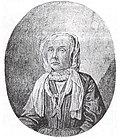
|
| Dorothea Christiane Erxleben | Dorothea Leporin-Erxleben | 1715 | Kingdom of Prussia | First German doctor and a pioneer in women's studies . |

|
| Dorothy Wordsworth | Dorothy Wordsworth | 1771 | England | English author, poet and diary writer. She had no aspirations to become a writer, and her writings consist only of letters, diary entries, poems, and short stories. |

|
| Elizabeth Cellier | Mrs. Cellier | 17th century | England | Catholic midwife in 17th century England. She was tried in 1679 for treason because of her alleged part in the "Meal-Tub Plot" against the later King James II , but acquitted. | |
| Émilie du Châtelet | Emilie du Chatelet | 1706 | Kingdom of France | Mathematician , physicist , philosopher and translator of the early enlightenment . Together with Voltaire she wrote the elements of Newton's philosophy . She also translated Newton's Philosophiae Naturalis Principia Mathematica and linked Newton's with Leibniz 's thinking. She also called for women to participate in all human rights . |

|
| Giustina Renier Michiel | Renier Michiel | 1755 | Republic of Venice | An aristocratic woman who helped the intellectual and social life of Venice to flourish. |
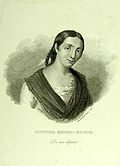
|
| Jeanne Dumée | Jeanne Dumeè | around 1680–1685 | Kingdom of France | Astronomer and author . She campaigned for the right to study for women. | |
| Jeanne Mance | Jeanne Mance | 1606 | Kingdom of France | Lay sister and nurse . She was involved in founding the city of Montreal and founded the Hôtel-Dieu de Montréal, the first hospital on Canadian soil. |

|
| Josephine Kablik | Josephine Kablick | 1787 | Bohemia | Botanist and paleontologist . Kablick studied among the best botanists of their time. She collected plant and fossil specimens for institutions across Europe. |
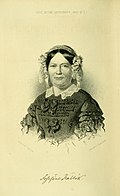
|
| Justine Siegemund | Justine Dietrich | 1636 | Mark Brandenburg | Midwife. As an autodidact, she made it from a village midwife to a midwife at the Brandenburg court and published the first German textbook for midwives (first edition 1690). |

|
| Kata Bethlen | Katherine Bethlen | 1700 | Kingdom of Hungary | Writer. | |
| Louyse Bourgeois | Louyse Bourgeois | 1563 | Kingdom of France | For 26 years, a midwife at the French royal court, a pioneer in obstetrics, replaced the obstetric textbook written by Trota ("Trotula von Salerno") in the 12th century with her midwifery book. |

|
| Luise of Marillac | Louise le Gras | 1591 | Kingdom of France | Noblewoman, founder of the order , founded the cooperative of the daughters of Christian love of St. Vincent de Paul with Vincent de Paul , is venerated as a saint in the Roman Catholic Church . |
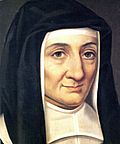
|
| Margaret Cavendish | Margaret Cavendish | 1623 | England | Noblewoman, philosopher, writer and scientist. |
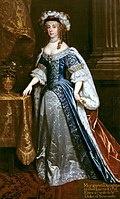
|
| Maria Cunitz | Maria Cunitz | 1610 | Duchy of Wohlau | One of the most important early modern astronomers in Europe. |

|
| Maria Margaretha Kirch | Maria Kirch | 1670 | Kingdom of Prussia | Astronomer , wife of Gottfried Kirch , discovered the comet from 1702 and is therefore the first woman to discover a comet. | |
| Maria Mitchell | Maria Mitchell | 1818 | United States | Astronomer and campaigner for women's rights . |

|
| Marie Colinet | Marie Colinet | around 1560 | Switzerland | Midwife and surgeon . | |
| Geneviève Thiroux d'Arconville | Genevieve d'Arconville | 1720 | Kingdom of France | Writer and French anatomist. |

|
| Marie Lavoisier | Marie Lavoisier | 1758 | Kingdom of France | Chemist , illustrator and salonnière , worked closely with her husband Antoine Laurent de Lavoisier . |

|
| Martha Mears | Martha Mears | 18th century | England | Midwife and author. | |
| Martine de Bertereau | Baroness de Beausaleil | around 1590 | Kingdom of France | Alchemist and mining expert . | |
| Mary Ann Lamb | Mary Lamb | 1764 | England | Writer and collaborator of her brother Charles Lamb, who also writes . |
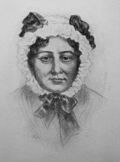
|
| Mary Somerville | Mary Somerville | 1780 | Scotland | Astronomer and mathematician, who autodidactically acquired her knowledge , achieved great fame as a science author. |
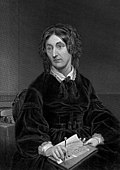
|
| Mother Hutton | Mother Hutton | 18th century | England | legendary figure, pharmacist and herbalist responsible for the discovery of digitalis and its essential use in the healing of heart problems. |

|
| Nicole-Reine Lepaute | Hortense Lepaut | 1723 | Kingdom of France | Astronomer during the Enlightenment . |

|
| Sophie Germain | Sophie Germain | 1776 | Kingdom of France | Mathematician . In 1805 she proved that Fermat's theorem applies to a group of prime numbers ( Sophie-Germain prime numbers ). |

|
- Individual evidence
- ^ Brooklyn Museum: Caroline Herschel. In: brooklynmuseum.org. Retrieved October 29, 2019 .
- ^ Brooklyn Museum: Mrs. Cellier. In: brooklynmuseum.org. Retrieved October 29, 2019 .
- ^ Brooklyn Museum: Renier Michiel. In: brooklynmuseum.org. Retrieved October 29, 2019 .
- ↑ Brooklyn Museum: Katherine Bethlen. In: brooklynmuseum.org. Retrieved October 29, 2019 .
- ↑ Brooklyn Museum: Martha Mears. In: brooklynmuseum.org. Retrieved October 29, 2019 .
- ↑ Brooklyn Museum: Mother Hutton. In: brooklynmuseum.org. Retrieved October 29, 2019 .
Web links
- Brooklyn Museum, Caroline Herschel
- The Dinner Party on the website of Through the Flower , Judy Chicago's non-profit organization
